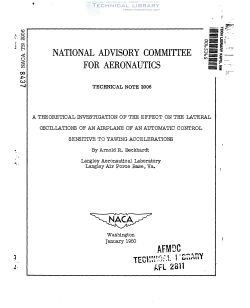naca-tn-2006
- Version
- 83 Downloads
- 858.37 KB File Size
- 1 File Count
- December 13, 2016 Create Date
- December 13, 2016 Last Updated
National Advisory Committee for Aeronautics, Technical Notes - A Theoretical Investigation of the Effect on the Lateral Oscillations of an Airplane of an Automatic Control Sensitive to Yawing Accelerations

A theoretical investigation was made to determine the effect on the
lateral oscillations of an airplane of an automatic centrol sensitive to
yawing accelerations. The investigation included calculations of the
effect of time lag in a control of this type on the damping of the
lateral oscillations of a typical high—speed airplane and also calcu— .
lations of the effect on the damping of varying the ratio of the rudder
deflection to the yawing acceleration. The inadequacy of the approximate
lag—operator method as a means of treating time lag is also discussed.
The results indicate that a control of this type can successfully
damp the lateral oscillations through a reasonable range of time lag.
The presence of the automatic control introduces a higher—frequency mode
of motion which becomes unstable with increasing time lag in addition to
the existing lower—frequency Dutch roll mode of motion which becomes
more stable with increasing time lag. Increasing the ratio of the rudder
deflection to the yawing acceleration imroved the damping of the lower—
frequency mode slightly but, at the same time, reduced rapidly the damping
of the higher—frequency mode.
With the increased speed range, altitude range, and density of
current airplanes, the problems of constant—amplitude lateral oscillations
and of poorly damped lateral oscillations have become more acute. The
familiar snaking oscillation is one example of this type of oscillation
which can occur. This type of oscillation may be very annoying to the ,
pilot on a long flight and. may also considerably reduce the accuracy of
gunfire or of rockets or bombs released from the airplane. Even in the
landing condition certain high—speed airplanes have developed poorly
damped Dutch roll oscillations which would be very critical during a
blind landing. In a fighter airplane these oscillations usually have
small amplitudes and short periods. The oscillations are obJectionable
even if the period is of the order of magnitude of 5 or 6 seconds such
as might be the case in a heavy bomber airplane, because the oscillations
still require close pilot attention for control.
In the past, satisfactory damping of the lateral oscillations has
been inherently provided in the airplane. It may not be possible to
provide enough inherent stability in future high—speed airplanes because
of the effect of factors such as Mach number and high airplane density;
therefore, some type of automatic control may be required in order to
damp these lateral oscillations.
| File | Action |
|---|---|
| naca-tn-2006 A Theoretical Investigation of the Effect on the Lateral Oscillations of an Airplane of an.pdf | Download |

Comment On This Post